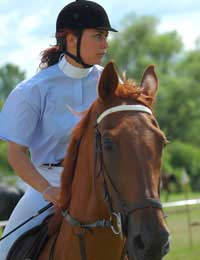Bridles and Accessories

Along with the saddle, the bridle is the most obvious piece of tack when you look at a horse. It can also look like the most confusing and complicated, especially when you are confronted with putting it on. But rest assured, once you get used to doing it, it will pop on and off safely in no time at all.
Parts of the Bridle and Accessories
The bridle is made up of many different parts, and knowing which is which and where it is supposed to go will help you greatly when you learn how to put it on your horse.- Reins – The reins are the straps which run from the horse’s head which the rider holds onto. The reins are vital as they are one of the main ways of controlling your horse, along with feet.
- Bit – The bit goes into the horse’s mouth and is usually made of some type of hard metal. It rests in a gap between the horse’s teeth, and the rider communicates with the horse through the reins, via the bit. Horses respond to subtle movements. It is important that the bit is never tugged on and that it sits comfortably in the horse’s mouth. If the horse is uncomfortable with it or in pain due to incorrect positioning, he may misbehave or even bolt.
- Headpiece – The headpiece goes over the horse’s forehead and holds the bridle in place.
- Browband – The browband runs across the front of the horse’s head, his brow, underneath his ears.
- Cheekpieces – The cheekpieces are the straps of leather which run down the cheeks from the headpiece to the bottom of the horse’s head.
Types of bridle
There are several different types of bridle although most riders will only need to know about the differences of a select few. Western style riders have different bridles to English riders, as do riders in other types of horsemanship.The hackamore is basically a bridle with no bit. Some argue that it is a more humane way of controlling the horse, although the majority of riders say the bit does not hurt the horse when employed correctly. The hackamore controls the horse via a nosepiece, running across the nose and connected to the reins.
A snaffle bridle is the most usual type of bridle in English riding, with one bit, and control made through it via the reins. Double bridles are also seen in English riding. They have two bits and are usually seen at very high level contests and dressage events.
Safety
As mentioned above, a bridle must be fitted properly otherwise it has the potential to make the horse uncomfortable and also unable to understand commands from the rider - this puts the rider in danger too.A horse should never be tied up by the reins. If a horse tied to a fence or post by its reins pulls back, it will hurt its mouth with the bit. If you need to tie your horse, you should remove the bridle and put on a halter instead.
If you learn to understand the bridle and how it works, you will be able to fully understand how the horse ‘hears’ commands you give it. This will make you a better rider and give you and your horse a stronger rapport together. You should remember the horse’s head is sensitive and should always be treated with care. Do this and your horse will love and respect you – so much the better for good riding.


Re: Body Protectors and Back Support
When wearing my back protector, my lower back actually hurts more. What should I do?
Re: How Riders Use Stirrups
Thank you for article. Could you elaborate more on why we use stirrups. Every search of "why we use stirrups" only gave a few sentence…
Re: Mucking Out
How old do you have to be able to do stable hand ?
Re: Showjumping: Where to Start
To compete at high levels in showjumping is it easier to have your own horse, share or loan? Thanks
Re: What Equipment Will You Need?
i have just starting riding only had one lesson already got the boots jodphurshat polo and whip im really serious about this
Re: What to Wear as a Beginner
I am a beginner and I was wondering what are the best joppers , gloves .etc. that I could buy could you help me.
Re: What Equipment Will You Need?
I found this very good because my daughter is at cantering stage and we were thinking about getting her a horse although did not…
Re: Riding Hats
I don't jump yet but I do a lot of canter work in my lessons. Do I need a body protector or not?
Re: What Equipment Will You Need?
I never had to use a helmet, crop, or proper clothing while training my horses. When I first got my Arabian cross she was crazy,…
Re: Horse Boxes and Trailers
@Darren - there are places that give horsebox driver training, so that you can drive with confidence, as it can be a stressful…